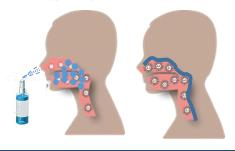CSIC and Universitat de València have developed novel polysaccharides that are effective in treatment and prevention of viral infections. These compounds are mimics of heparan sulfates, naturally occurring sulfated polysaccharides present in cells. They act as decoy trap preventing the virus from adhering to epithelial cells, thus slowing down the process of infection. Their antiviral activity has been successfully tested for SARS-CoV-2 and Respiratory Syncytial Virus.
Industrial partners from pharmaceutical industry interested in a patent licence agreement for further development and commercial exploitation of this technology are being sought.
An offer for Patent Licensing
A therapeutic solution for SARS-CoV-2
These new compounds sprayed into the nasal cavity creates a protective layer in the mucose that helps to reduce the spreading and proliferation of the virus Enveloped virus, such as coronavirus SARS-CoV-2 or RSV, can produce severe respiratory infections by infecting and replicating in the airway epithelia. It is well-known that these virus binding to cells involves and initial interaction between the basic amino acids present on the viral envelope proteins and heparan sulfate proteoglycans (HSPGs). Thus, it has been reported that virus employ HSPGs as adhesion molecules to increase the density of the virus on cell surface and possibly facilitating the interaction between the envelope proteins and their cellular receptors.
Researchers of CSIC and UV have developed novel polysaccharides that mimic the structure of heparan sulfates (HS), binding the virus and forming a shielding layer on the virus surface by their interaction with viral envelope proteins, inhibiting the process of infection. Antiviral activity of these derivatives was successfully tested for SARS-CoV-2 and RSV finding that infection was significantly reduced upon its addition.
Main innovations and advantages
- The synthesis of these compounds is simple and can be scaled atindustrial level. Besides the raw materials required are commonly usedin chemical and/or pharmaceutical industry.
- These new compounds could be useful for the treatment and/orprevention of infections caused by SARS-CoV-2 such as COVID-19
- They can also be effective for treatment of other viruses that alsoproduce severe respiratory infections such as human respiratorysyncytial virus (RSV) or influenza virus.






